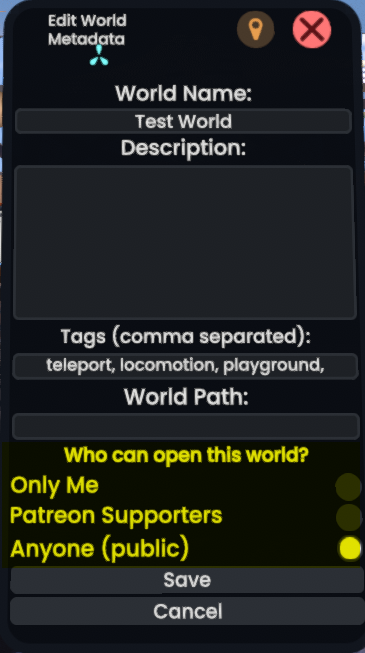A common goal for Headlesses is to load a specific world on start-up. This article guides you through doing that with the goal of as much success as possible.
Preparing the World for a Headless
The first step is also the most important for success, we need to ensure the world is ready for a Headless. The steps required for this depend on where the world will be stored.
- Using User's Inventory
- Using a Group's Inventory
- This option is the easiest, but does require a Group
User's inventory
- Setup your world as per normal
- Save your world to your inventory
- Spawn a world orb of the world and click on it
- Select "Edit Meta-Data"
- Ensure "Who can open this world?" is set to "Anyone"
- Click save
- Wait for your Sync status to say "All Synced"
Group's inventory
- Setup your world as per normal
- Save your world to your Group's Inventory
- Ensure that the Headless User is a member of your target Group
- Wait for your Sync status to say "All Synced"
Getting the Record URL
The next step is ensuring that you have the correct url. There are a variety of world urls available and for Headlesses you need the "Record Url".
To get this:
- Select the world in the World Browser
- Click the Right Arrow in the top right of the world preview. This will open an expanded world dialog.
- Click "Copy Record URL"
If you want to check if the URL is correct, ensure that it starts with resrec:///, it should also have your user id, or group id as the first part of the URL.
resrec:///GROUP OR USER ID/WORLD RECORD ID
Adding the Record URL to the configuration
Once you have the Record URL, you just need to add it to the Headless Server Software/Configuration File, in the loadWorldURL property of a world.
An example is available on our example configuration page.
See Also
- Setup a Headless - How to setup a headless for the first time
- Managing Worlds - Guidance on world management with a headless.
- Docker Setup - Guidance on creating a headless using Docker.
- Configuration File - Learn about Headless Configuration Files
- Commands - Learn about Headless Commands
- Troubleshooting - A guide for troubleshooting Headless issues.
Further Help
If you need further help then you can:
